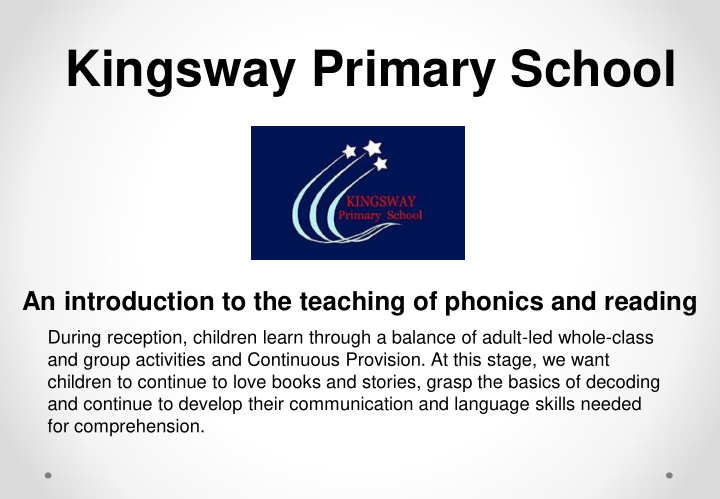



Kingsway Primary School An introduction to the teaching of phonics and reading During reception, children learn through a balance of adult-led whole-class and group activities and Continuous Provision. At this stage, we want children to continue to love books and stories, grasp the basics of decoding and continue to develop their communication and language skills needed for comprehension.
Up to this point… Your child will have: • Learnt to enjoy stories (been encouraged to join in repetitive refrains) and use stories/narrative within their play • Experienced rhyme and alliteration through songs, stories and games • Experimented with making noises (body percussion/oral) and encouraged to distinguish and identify between sounds
This year... Alongside teaching your child synthetic phonics, we will continue to build upon Nursery/Pre-School experiences and learning through daily story time. Phonics gives children the opportunity to orally segment and blend sounds in words, experiment with making sounds and be able to distinguish between different sounds. • Segment: Is when you split a word up into sounds (phonemes), you are „sounding it out‟ e.g. cat would be c -a-t. • Blend : Is when you say the sounds (phonemes) together to make a word, you are pushing the sounds together. e.g. d-o-g (segmented) dog (blended).
What can I do at home to help prepare my child for reading? • Talk about print as you see it around you at home or in the street, i.e. the writing on a cereal packet, the name of your street, shop signs, etc. • It will help if your child sees you reading. Children like to copy their parents…magazines, the newspaper, iPad, recipes, books etc. • Children learn best when they feel confident, so try to find something encouraging to say about your child‟s reading .
Phonic Lessons- What do we do? • Continue to develop listening skills and exploration of sounds • Teach letter sounds (Phonemes)-one per day. (Voiced and unvoiced) • Teach letter shapes (Graphemes) • How to blend sounds together for reading • How to segment sounds for writing • Word recognition (where phonics can not be applied)
Your child’s orange phonic book • It follows the Jolly Phonics scheme together with Letters and Sounds; • Encourage children to practise the sound and action by looking at the letter, not just the picture; • The children MUST use soft sounds when pronouncing the sound • Continue to look through this book daily and practise reading and writing the letters, even after all the sounds have been taught.
Tricky Words • These words will be given as a laminated strip on a key ring. • The coloured lists are “tricky words” and are to be learnt by heart; they are not to be sounded out and cannot be blended. • We will add new words when we feel your child is ready. Your child must be confident to read these words in books as well as in any order on their word list. • Please practise reading the words in a random order to ensure they are learnt instead of simply memorised. PLEASE DO NOT SOUND OUT!
White Word Lists • These are „high frequency words‟ and ones which need to be read by blending the sounds together. Coloured word lists White word lists (blend)
The Reading Book • Read the title and talk about the front cover and what the book might be about; • Your child will bring home picture books at first. Look at the pictures and make up stories together about what you think is happening. Discuss how the characters might say something, how they may be feeling and what the problem of the story is. • Read the story together with your child pointing at the words, predict what might happen next, look for words they can sound out and those they may have seen on coloured word lists (tricky words). • Talk about the book together, about the characters and the storyline, encourage your child to relate to the story and think about emotions • Ask Who? Why? What? Do you think…? Use „I wonder‟ prompts • Enjoy the books together! Re-read them. Make up multiple versions! • 1 reading book chosen by teacher (appropriate phonic level) and 1 library book chosen by child
Reading Record book • Use one row per reading book to add a comment. Please also include books that are not the school reading book. • Jot down a comment, such as, “Read well,” “Enjoyed story,” “Had trouble with…” etc. • You do not need to write a comment for every time you hear your child read, but we need at least one comment per book. A signature or smiley face will let us know you have read. • If a comment is not made we will assume the book has not been read at home. • When the book has been read at home, we will be happy to change it. Reading levels will be monitored and assessed by the class teacher and changed when appropriate.
I need help! If they get stuck: Wait 5- 10 seconds…… • Use picture clues • Use initial sounds • Guess from the context • Read back and guess • Read on then guess • Say it for them What matters is that your child can make sense of what they are reading.
Recommend
More recommend